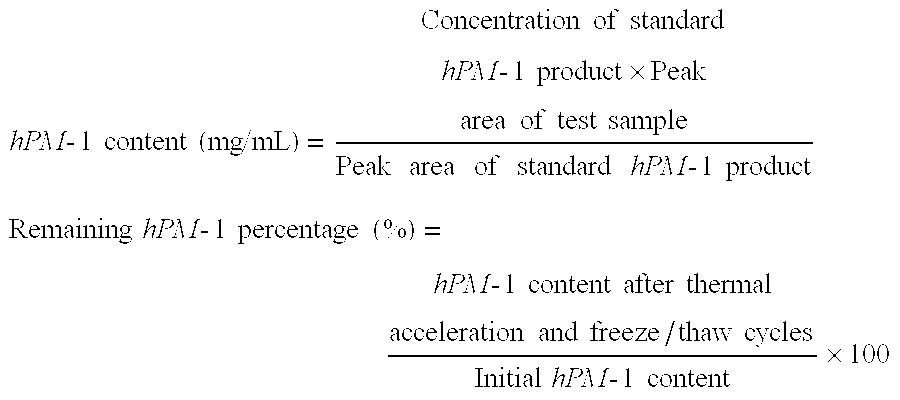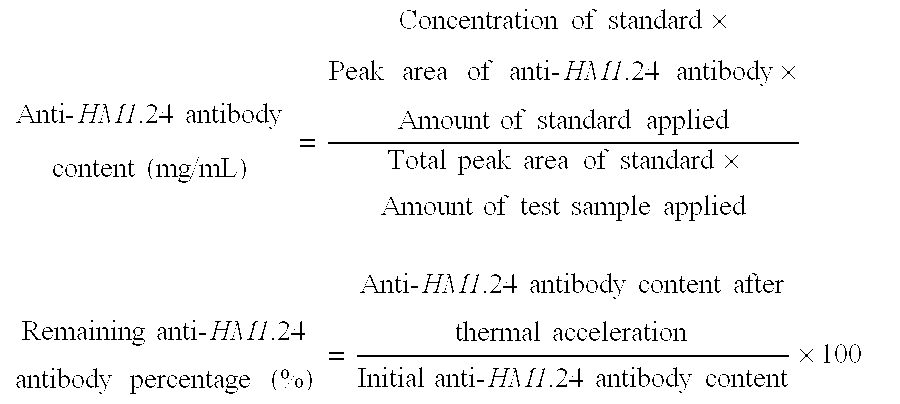Antibody-containing solution pharmaceuticals
a technology of antibody-containing solution and pharmaceuticals, which is applied in the direction of immunological disorders, drug compositions, peptides, etc., can solve the problems of inconvenient addition of biopolymers such as proteins as stabilizers, decreased antibody content in such a solution, and insoluble aggregates, etc., to inhibit degradation products
- Summary
- Abstract
- Description
- Claims
- Application Information
AI Technical Summary
Benefits of technology
Problems solved by technology
Method used
Image
Examples
example 1
Effects of Adding A Surfactant (1)
[0093] The influence of a surfactant (Polysorbate 80) on heat stability and freeze / thaw stability was tested. Samples containing Polysorbate 80 at various concentrations shown in Table 1 were prepared and tested as follows.
[0094] (1) Stability to thermal acceleration (50° C.-2W) was evaluated from the remaining hPM-1 percentage and the formation of multimers and degradation products as determined by gel permeation chromatography (GPC). The number of insoluble particles per mL was measured by an automatic light obscuration particle counter (HIAC).
[0095] (2) Stability to freeze / thaw cycling (3 cycles of storage at −20° C. for 3 days and then 5° C. for one day) was evaluated from the remaining hPM-1 percentage and the formation of multimers and degradation products as determined by gel permeation chromatography (GPC). The number of insoluble particles per mL was measured by an automatic light obscuration particle counter (HIAC).
[0096] The results o...
example 2
Effects of Adding A Surfactant (2)
[0098] The influence of a surfactant (Polysorbate 80) on stability to freeze / thaw cycling and shaking was tested. Samples containing Polysorbate 80 at various concentrations shown in Table 2 were prepared and tested as follows.
[0099] Stability to freeze / thaw cycling (2 cycles of storage at −20° C. for 8 hours and then 5° C. for 8 hours) was evaluated from the number of insoluble particles per mL as measured by an automatic light obscuration particle counter (HIAC). The presence or absence of insoluble matters was evaluated by automated visual inspection.
[0100] The results obtained are shown in Table 2.
TABLE 2Sample 5Sample 6Sample 7Sample 8Sample 9Sample 10hPM-1 (mg / mL)202020202020Polysorbate 80 (mg / mL)00.0050.050.250.50.75Sucrose (mg / mL)505050505050Sodium Phosphate (mM)151515151515pH6.56.56.56.56.56.5InitialNumber of1000000particles of10 μm or more(particles / mL)Number of200000particles of25 μm or more(particles / mL)InsolubleYesNoNoNoNoNomatters...
example 3
Effects of Adding Sugars
[0102] The influence of adding sugars on freeze / thaw stability was tested. Samples containing various sugars shown in Table 3 (sucrose, mannitol, trehalose) were prepared and evaluated for stability to freeze / thaw cycling (22 cycles of storage at −20° C. for 2 hours and then 5° C. for 2 hours) as determined by gel permeation chromatography (GPC) from the amount of dimers formed.
TABLE 3SampleSampleSampleSampleSample1112131415hPM-1 (mg / mL)2020202020Sucrose (mg / mL)050000Mannitol (mg / mL)0050940Trehalose (mg · mL)000050Polysorbate 80 (mg / mL)0.50.50.50.50.5Sodium Phosphate (mM)1515151515pH6.56.56.56.56.5InitialDimers0.420.430.410.380.42(%)Freeze / Dimers0.670.430.892.600.41thaw(%)(−20° C.→5° C.,22 cycles)
[0103] It was found that the formation of dimers is inhibited by the addition of sucrose and trehalose.
PUM
| Property | Measurement | Unit |
|---|---|---|
| structure | aaaaa | aaaaa |
| concentration | aaaaa | aaaaa |
| Insoluble Particulate Matter Test | aaaaa | aaaaa |
Abstract
Description
Claims
Application Information
 Login to View More
Login to View More - R&D
- Intellectual Property
- Life Sciences
- Materials
- Tech Scout
- Unparalleled Data Quality
- Higher Quality Content
- 60% Fewer Hallucinations
Browse by: Latest US Patents, China's latest patents, Technical Efficacy Thesaurus, Application Domain, Technology Topic, Popular Technical Reports.
© 2025 PatSnap. All rights reserved.Legal|Privacy policy|Modern Slavery Act Transparency Statement|Sitemap|About US| Contact US: help@patsnap.com



